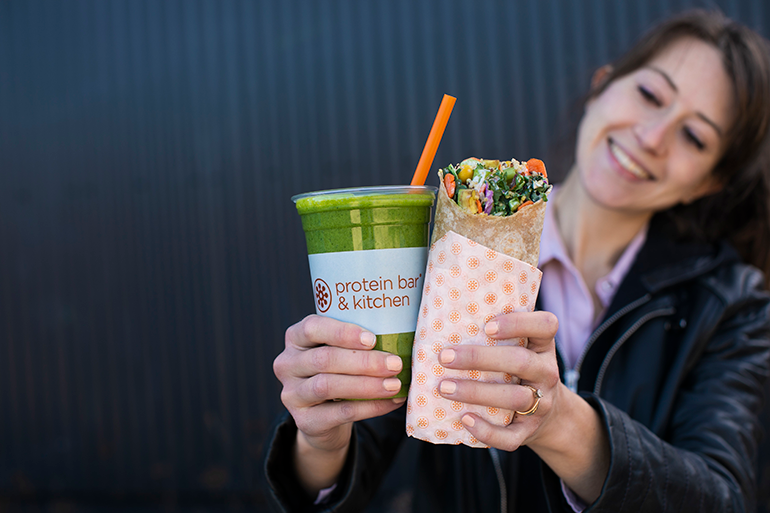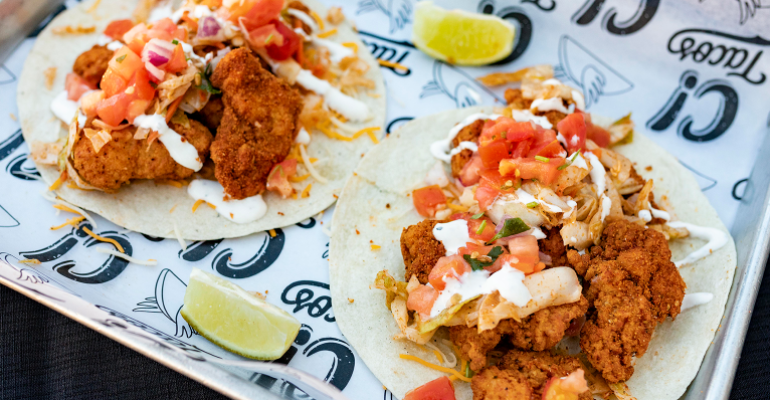Pre-pandemic, digital technology leadership was mostly relegated to the largest brands, like Domino’s, Chipotle, and Panera Bread. But with recent consumer demand shifts toward omnichannel convenience, there is no reason why emerging operators can’t also invest in tech-driven guest experiences.
According to the 2023 Restaurant Technology Outlook survey recently released by Nation’s Restaurant News, the No. 1 concern that might be holding operators back in the technology space is cost. In the survey, 74% of the nearly 400 operator respondents said that cost is in their top three considerations when vetting or investing in new technology. In fact, according to the survey, cost is the No. 1 obstacle for operators looking to invest in new tech, and 20% said that they’re overwhelmed by all the tech options out there.
But there are multiple pathways toward achieving tech efficiency without breaking the bank or needing to mimic the complex (and even proprietary) tech stacks of the biggest chains in the restaurant industry.
“The first thing I always tell people is go look at your closest competitors in your space, because there's this perception that everybody has tech all figured out, and the truth is, most don't,” said Jeremy Julian, COO of Custom Business Solutions and founder of Restaurant Technology Guys. “Everybody thinks they need to have an app, but do you really? … You don’t have to have [every piece of technology] that everybody else has and you can still run a sustainable, viable business.”
Take time to know what your brand needs
This is why the No. 1 rule of technology efficiency is to confidently know both your customer-facing and employee-facing operational needs, and how technology can help you fulfill those needs. Even a decision as centric as choosing a point-of-sale system is not as simple as signing a contract with the most well-known name or the one that sends out the most email blasts.
Josh Luger, cofounder of Tampa, Fla.-based fast-casual taco brand Capital Tacos, said that he and his team recently redesigned their POS system from scratch, switched providers, and went over each line of code to create a better system to help their kitchens run more smoothly. The goal was to allow new employees to jump on the line on their first day of the job and be able to make any menu item without issue or confusion using the back-of-house technology. Despite the time, precise effort, and financial investment spent on rebuilding their POS, the investment pays for itself many times over in the long run, he said.
“Whether you’re trying to implement a POS provider or online ordering software, it’s a matter of doing your research and talking with five or six options at once and asking them the tough questions,” Luger said. “These are not quick decisions; these are decisions made over months. … Ask them to build you a prototype and show you how it’s working with one of their customers. Ask about integrations with other vendors.”
This process looks different for everyone, depending on the size, category, and goals of your brand. The better you know your brand needs, Julian said, the more accurately you’ll be able to answer the question, “Do I really need this?”
Do I need an app? And other similar questions
Each of the operators and experts interviewed for this story believe that many brands do not need their own app. Even though developing an app might seem like the next logical tech investment for a growing operator with a digitally savvy customer base, the reality is that very few consumers have more than a couple of foodservice apps on their phone.
“I think for an emerging brand, figuring out whether or not you need an app comes down to knowing who your customer is and how you think they're going to use your business,” said Jared Cohen, chief operating officer of Chicago-based healthy fast-casual concept, Protein Bar. “For a more experiential, less routine experience, it becomes less of a critical need. But for us, we're a brand that aspires to be high-frequency use. People will come in and get a shake from Protein Bar in the same way they get their coffee from Starbucks. For that type of use occasion, we thought an app was important.”
Since familiarizing themselves with what their ideal customer looked like, Protein Bar leaders chose to be an early adapter (especially for an emerging brand) and built an app with the help of a third-party developer in 2017, with a new version pushed out in 2018, and delivery capabilities added to the app two years later.

Protein Bar leaders chose to be an early adapter and built an app with the help of a third-party developer in 2017, with a new version pushed out in 2018, and delivery capabilities added two years later.
Even if you want to have a user-friendly online ordering system, there are options beyond building an app in-house, like using white-label third-party solutions and having a robust mobile web experience, experts said.
“I don’t know that having an app is necessarily a priority,” said Michael “Schatzy” Schatzberg, co-managing partner at Branded Strategic Hospitality. “As technology starts changing, and no one's really putting in the time and energy to evolve that loyalty program, by year five, you've got a really old, outdated rewards app that you spent thousands of dollars building, instead of going with a third-party whose only purpose is building and updating that platform.”
Don’t fall prey to the bells and whistles
Whether or not you think building an app is necessary, the lesson is to keep focused on what your brand needs instead of becoming a victim of “shiny object syndrome.” Just because everyone is talking about the latest thing — whether that’s the metaverse, cryptocurrency, or AI — doesn’t mean that it’s a good fit for every operator.
“You need to identify your biggest pain points and then try to check them off one by one,” Schatzberg said. “Just remember that there’s a lot of technology out there that you could buy and find out it’s not useable. Make sure your team buys into whatever you invest in, and it’s solving some of their most pressing problems.”
It can be very easy to get caught up in saying yes to vendors just because you think you might need it, especially if the technology doesn’t seem frivolous.
“I always start with asking, ‘what are we already paying for?’ Because very often, we’re not fully tapping those resources,” said Emma Blecker, chief of staff and director of business systems at Boqueria, a fine-dining restaurant group based in New York City. “And there’s a flip side of it, with POS systems all scrambling to offer the latest bells and whistles. … I think of how a KitchenAid offers different attachments like a meat grinder or ice cream maker, and they all make sense. But if there was a KitchenAid attachment that let you do a tiny load of laundry, that would be the wrong place for it.”

Play Goldilocks with tech vendors
Once you have identified which bells and whistles are actually worth investing in for your brand, the next question many operators have is “how many vendors do I really need?” Many operators choose to partner with one of the larger POS vendors to create a one-stop-shop for all their tech needs, or at least use the platform as a starting point.
“The vendors out there that only do scheduling, their product might be 10 or 15%, better for scheduling, but for our purposes, we realized we don’t need that extra 10-15%,” Capital Tacos’ Luger said about using the POS for staff scheduling needs. “They have the ability to upload photos and videos of menu steps and the ability to communicate internally to the team. Sometimes you want to stand on products that are the best of the best, but we have resisted that on the labor side.”
But it isn’t wise to put all of your eggs in one basket, Julian said, even though it’s tempting to sign a contract with the biggest POS system you’ve heard of and just utilize whatever functionalities they offer.
“Once you do that, you have zero negotiating power,” he said, “and they have you right where they want you. I encourage people to find the right solution to fit their needs, even if that’s with multiple partners.”
So what is the ideal number of vendors for an operator looking to be tech-savvy but not break the bank? Julian said the average number of vendors used by the restaurants they consult with is around 15-20.
At Boqueria, Blecker said their team has a rule that when bringing on a new platform: It has to remove at least one other vendor from their tech stack. That way, the company can make sure they’re not overcomplicating the stack.
“This rule forces you to understand actual cost savings and think about the business holistically,” Blecker said. “When we started with SpotOn and Teamwork, it took away our old PTO process and our scheduling process, and our team communications. It took away like 10 platforms.”
Think in long-term investments, not upfront costs
One of the most common questions asked when building a tech stack is, “Is expensive technology necessarily better?” While there’s no easy answer to that, the truth is that just because a (usually larger) restaurant operator invests heavily in all of the latest, shiny-new technology capabilities does not mean that the tech works well.
“Multiple times I've talked to people about national brands where they refuse to order via the app or via third-party delivery because the experience has been so bad,” Julian said. “Just because you have an app or have online ordering capabilities doesn’t mean it’s netting you what you want. Maybe you’re losing 20% of your customers because you can’t execute on the product.”
Picking the wrong tech provider is one of the most expensive decisions you can make, he said, which is especially crucial when you’re about to sign a multi-year contract with a vendor. Two of the most important questions to ask when it comes to vendor contract commitments are, “Does this tech vendor integrate with the rest of my tech stack?” and “Is this long-term investment worth the upfront cost?”
“We look at the cost-benefit analysis of every one of our technology decisions because each one is an incremental cost both in dollars and training time for your team,” Protein Bar’s Cohen said. “When we were debating the third-party integration partnership with Chowly, it was a no-brainer when you think of the volume we did on the third-party marketplaces, and the accuracy issues inherent with staff members. … The case for automatically integrating all that order flow directly into our POS sold itself.”
The most crucial aspect of long-term thinking is to make sure that your tech stack is able to grow with your business, so that you don’t outgrow your tech stack as you scale. The key, Cohen said, is to avoid long-term commitments so that you can test out new technology on a pilot level before signing a multi-year, systemwide contract with a tech vendor. This is how you set yourself on the path toward restaurant tech leadership even if you don’t have thousands of locations in your portfolio.
“Our customer prioritizes convenience, so we need to be as close as we can to the leading edge of technology-enabled restaurant experiences,” Cohen said. “We want them to think of us in the same breath as Chipotle or Starbucks even though we’re operating with only one full-time technology budget and 1/1000th of the budget as the big guys.”
Contact Joanna at [email protected]




